Mechanisms of action of triptolide against colorectal cancer: insights from proteomic and phosphoproteomic analyses
- PMID: 35366242
- PMCID: PMC9037262
- DOI: 10.18632/aging.203992
Mechanisms of action of triptolide against colorectal cancer: insights from proteomic and phosphoproteomic analyses
Abstract
Triptolide is a potent anti-inflammatory agent that also possesses anticancer activity, including against colorectal cancer (CRC), one of the most frequent cancers around the world. In order to clarify how triptolide may be effective against CRC, we analyzed the proteome and phosphoproteome of CRC cell line HCT116 after incubation for 48 h with the drug (40 nM) or vehicle. Tandem mass tagging led to the identification of 403 proteins whose levels increased and 559 whose levels decreased in the presence of triptolide. We also identified 3,110 sites in proteins that were phosphorylated at higher levels and 3,161 sites phosphorylated at lower levels in the presence of the drug. Analysis of these differentially expressed and/or phosphorylated proteins showed that they were enriched in pathways involving ribosome biogenesis, PI3K-Akt signaling, MAPK signaling, nucleic acid binding as well as other pathways. Protein-protein interactions were explored using the STRING database, and we identified nine protein modules and 15 hub proteins. Finally, we identified 57 motifs using motif analysis of phosphosites and found 16 motifs were experimentally verified for known protein kinases, while 41 appear to be novel. These findings may help clarify how triptolide works against CRC and may guide the development of novel treatments.
Keywords: colorectal cancer; molecular docking; phosphoproteomic; proteomic; triptolide.
Conflict of interest statement
Figures
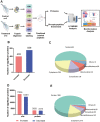

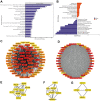
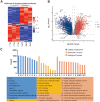
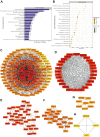

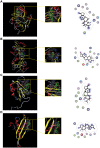
Similar articles
-
ITRAQ-Based Proteomics Analysis of Triptolide On Human A549 Lung Adenocarcinoma Cells.Cell Physiol Biochem. 2018;45(3):917-934. doi: 10.1159/000487286. Epub 2018 Feb 2. Cell Physiol Biochem. 2018. PMID: 29428961
-
Triptolide inhibits PDGF-induced proliferation of ASMCs through G0/G1 cell cycle arrest and suppression of the AKT/NF-κB/cyclinD1 signaling pathway.Eur J Pharmacol. 2020 Jan 15;867:172811. doi: 10.1016/j.ejphar.2019.172811. Epub 2019 Nov 19. Eur J Pharmacol. 2020. PMID: 31756335
-
Triptolide Attenuates Renal Tubular Epithelial-mesenchymal Transition Via the MiR-188-5p-mediated PI3K/AKT Pathway in Diabetic Kidney Disease.Int J Biol Sci. 2018 Sep 7;14(11):1545-1557. doi: 10.7150/ijbs.24032. eCollection 2018. Int J Biol Sci. 2018. PMID: 30263007 Free PMC article.
-
Triptolide and Its Derivatives as Cancer Therapies.Trends Pharmacol Sci. 2019 May;40(5):327-341. doi: 10.1016/j.tips.2019.03.002. Epub 2019 Apr 8. Trends Pharmacol Sci. 2019. PMID: 30975442 Review.
-
Broad targeting of triptolide to resistance and sensitization for cancer therapy.Biomed Pharmacother. 2018 Aug;104:771-780. doi: 10.1016/j.biopha.2018.05.088. Epub 2018 May 29. Biomed Pharmacother. 2018. PMID: 29807227 Review.
Cited by
-
SATB1 in cancer progression and metastasis: mechanisms and therapeutic potential.Front Oncol. 2025 Feb 25;15:1535929. doi: 10.3389/fonc.2025.1535929. eCollection 2025. Front Oncol. 2025. PMID: 40071088 Free PMC article. Review.
-
Triptolide suppresses IL-1β-induced expression of interleukin-8 by inhibiting ROS-Mediated ERK, AP-1, and NF-κB molecules in human gastric cancer AGS cells.Front Oncol. 2025 Jan 30;14:1498213. doi: 10.3389/fonc.2024.1498213. eCollection 2024. Front Oncol. 2025. PMID: 39950099 Free PMC article.
-
The molecular pathogenesis of triptolide-induced hepatotoxicity.Front Pharmacol. 2022 Aug 24;13:979307. doi: 10.3389/fphar.2022.979307. eCollection 2022. Front Pharmacol. 2022. PMID: 36091841 Free PMC article. Review.
-
The therapeutic potential of natural products for treating pancreatic cancer.Front Pharmacol. 2022 Nov 2;13:1051952. doi: 10.3389/fphar.2022.1051952. eCollection 2022. Front Pharmacol. 2022. PMID: 36408249 Free PMC article. Review.
-
Nucleo-cytoplasmic shuttling of 14-3-3 epsilon carrying hnRNP C promotes autophagy.Cancer Biol Ther. 2023 Dec 31;24(1):2246203. doi: 10.1080/15384047.2023.2246203. Cancer Biol Ther. 2023. PMID: 37599448 Free PMC article.
References
-
- Oliveira A, Beyer G, Chugh R, Skube SJ, Majumder K, Banerjee S, Sangwan V, Li L, Dawra R, Subramanian S, Saluja A, Dudeja V. Triptolide abrogates growth of colon cancer and induces cell cycle arrest by inhibiting transcriptional activation of E2F. Lab Invest. 2015; 95:648–59. 10.1038/labinvest.2015.46 - DOI - PMC - PubMed
-
- Acikgoz E, Tatar C, Oktem G. Triptolide inhibits CD133+ /CD44+ colon cancer stem cell growth and migration through triggering apoptosis and represses epithelial-mesenchymal transition via downregulating expressions of snail, slug, and twist. J Cell Biochem. 2020; 121:3313–24. 10.1002/jcb.29602 - DOI - PubMed
Publication types
MeSH terms
Substances
LinkOut - more resources
Full Text Sources
Medical

